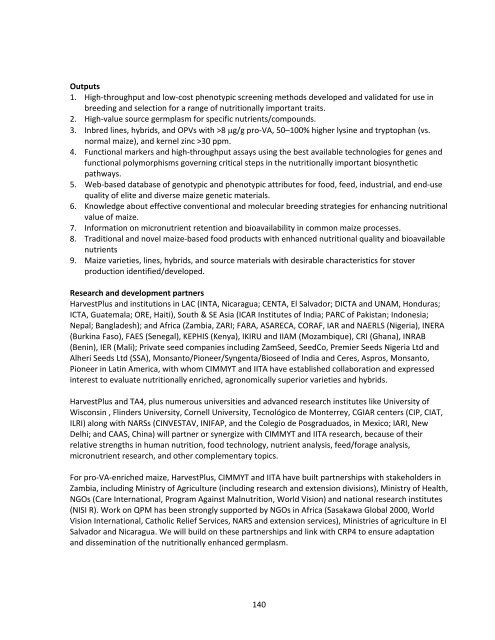Download - Maize
Download - Maize
Download - Maize
You also want an ePaper? Increase the reach of your titles
YUMPU automatically turns print PDFs into web optimized ePapers that Google loves.
Outputs<br />
1. High‐throughput and low‐cost phenotypic screening methods developed and validated for use in<br />
breeding and selection for a range of nutritionally important traits.<br />
2. High‐value source germplasm for specific nutrients/compounds.<br />
3. Inbred lines, hybrids, and OPVs with >8 g/g pro‐VA, 50–100% higher lysine and tryptophan (vs.<br />
normal maize), and kernel zinc >30 ppm.<br />
4. Functional markers and high‐throughput assays using the best available technologies for genes and<br />
functional polymorphisms governing critical steps in the nutritionally important biosynthetic<br />
pathways.<br />
5. Web‐based database of genotypic and phenotypic attributes for food, feed, industrial, and end‐use<br />
quality of elite and diverse maize genetic materials.<br />
6. Knowledge about effective conventional and molecular breeding strategies for enhancing nutritional<br />
value of maize.<br />
7. Information on micronutrient retention and bioavailability in common maize processes.<br />
8. Traditional and novel maize‐based food products with enhanced nutritional quality and bioavailable<br />
nutrients<br />
9. <strong>Maize</strong> varieties, lines, hybrids, and source materials with desirable characteristics for stover<br />
production identified/developed.<br />
Research and development partners<br />
HarvestPlus and institutions in LAC (INTA, Nicaragua; CENTA, El Salvador; DICTA and UNAM, Honduras;<br />
ICTA, Guatemala; ORE, Haiti), South & SE Asia (ICAR Institutes of India; PARC of Pakistan; Indonesia;<br />
Nepal; Bangladesh); and Africa (Zambia, ZARI; FARA, ASARECA, CORAF, IAR and NAERLS (Nigeria), INERA<br />
(Burkina Faso), FAES (Senegal), KEPHIS (Kenya), IKIRU and IIAM (Mozambique), CRI (Ghana), INRAB<br />
(Benin), IER (Mali); Private seed companies including ZamSeed, SeedCo, Premier Seeds Nigeria Ltd and<br />
Alheri Seeds Ltd (SSA), Monsanto/Pioneer/Syngenta/Bioseed of India and Ceres, Aspros, Monsanto,<br />
Pioneer in Latin America, with whom CIMMYT and IITA have established collaboration and expressed<br />
interest to evaluate nutritionally enriched, agronomically superior varieties and hybrids.<br />
HarvestPlus and TA4, plus numerous universities and advanced research institutes like University of<br />
Wisconsin , Flinders University, Cornell University, Tecnológico de Monterrey, CGIAR centers (CIP, CIAT,<br />
ILRI) along with NARSs (CINVESTAV, INIFAP, and the Colegio de Posgraduados, in Mexico; IARI, New<br />
Delhi; and CAAS, China) will partner or synergize with CIMMYT and IITA research, because of their<br />
relative strengths in human nutrition, food technology, nutrient analysis, feed/forage analysis,<br />
micronutrient research, and other complementary topics.<br />
For pro‐VA‐enriched maize, HarvestPlus, CIMMYT and IITA have built partnerships with stakeholders in<br />
Zambia, including Ministry of Agriculture (including research and extension divisions), Ministry of Health,<br />
NGOs (Care International, Program Against Malnutrition, World Vision) and national research institutes<br />
(NISI R). Work on QPM has been strongly supported by NGOs in Africa (Sasakawa Global 2000, World<br />
Vision International, Catholic Relief Services, NARS and extension services), Ministries of agriculture in El<br />
Salvador and Nicaragua. We will build on these partnerships and link with CRP4 to ensure adaptation<br />
and dissemination of the nutritionally enhanced germplasm.<br />
140

















